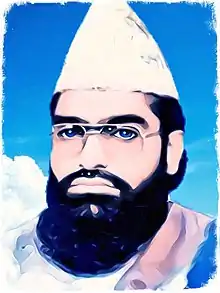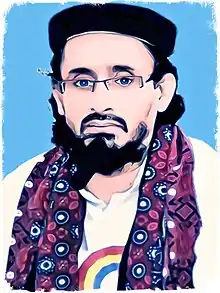Sipah-e-Sahaba Pakistan
Sipah-e-Sahaba Pakistan (SSP, Urdu: سپاہ صحابہ, Guardians of the Prophet's Companions), renamed to Millat-e-Islamia, is a Muslim organisation in Pakistan, which also functioned as a political party. It broke away from the main Deobandi Sunni organisation Jamiatul Ulema-e-Islam in 1985. Established in Jhang by Haq Nawaz Jhangvi, it was banned by President Pervez Musharraf in 2002 as a terrorist organisation under the Anti-Terrorism Act of 1997.[1][2] The fact based account is presented in the book In the Line of Fire: A Memoir by Pervez Musharraf. In March 2012, the government of Pakistan banned Sipah-e-Sahaba again.[3][4] The government of the United Kingdom banned the group earlier in 2001.[5]
| Sipah-e-Sahaba Pakistan | |
|---|---|
| سپاہ صحابہ | |
 | |
| Leaders | Muhammad Ahmed Ludhianvi Aurangzaib Farooqi |
| Motives | Genocide of the Shia community in Pakistan |
| Active regions | Pakistan |
| Ideology | Anti-Shi'ism Deobandi Salafism |
| Political position | Far-right |
| Colours | Green |
| Part of a series on |
| Deobandism |
|---|
 |
| Ideology and influences |
| Founders and key figures |
|
| Notable institutions |
| Centres (markaz) of Tablighi Jamaat |
| Associated organizations |
On 26 June 2018, before that year’s election, the Government of Pakistan lifted the ban on Sipah-e-Sahaba Pakistan.[6][7][8]
Their main current front is the Pakistan Rah-e-Haq Party, which they contested the 2018 general elections with and the 2020 Gilgit-Baltistan Assembly elections with.[9]
History
Sipah-e-Sahaba Pakistan was formed in 1985 by Haq Nawaz Jhangvi, Zia-ur-Rehman Farooqi, Isar-ul-Haq Qasmi and Azam Tariq in 1985 originally as Anjuman Sipah-e-Sahaba in Jhang, Pakistan.[4][10][11] The original purpose was to fight Shi'ite landlords dominance in Jhang and surrounding areas in a majority Sunni population.[10] Later, they became violent and started to attack Shi'ite Muslims.[10] From 1980s, they are involved in various terrorist activities and murder of thousands of Shi'ites. They are operating all over Pakistan and are politically active having large vote bank in Punjab and Khyber Pakhtunkhwa (KP).[10] They are widely organized and have more than five hundred offices throughout country.[10]
In 1996, many left the group and formed another organization Lashkar-e-Jhangvi (LeJ).[10]
In 2002, Pervez Musharraf government declared the group as terrorist organization and was banned.[10] However, later, they renamed it and launched it under the name of Millat-e-Islamia Pakistan.[10] They were again banned in 2003.[10] After the death of Azam Tariq , Muhammad Ahmed Ludhianvi was selected as the president.
A leader of Sipah-e-Sahaba was a minister in the coalition Government in Punjab in 1993 and the group has held seats in the Pakistan National Assembly.[2][4]
When Jhangvi was assassinated in 1990 by presumed Shi'a militants, Zia-ur Rehman Farooqi assumed leadership of the group. Zia-ur-Rehman Farooqi died in a bomb explosion on 19 January 1997 at the Lahore Session Court.[4] After his death, Azam Tariq led the group until October 2003, when he was also killed in an attack widely attributed to the militant Shi'a organization Sipah-e-Muhammad, along with four others.[2][4]
Its leader (sarparast-aala), Ali Sher Haideri, was killed in an ambush in 2009.[12] Then Muhammad Ahmed Ludhianvi was selected as sarparast-e-aala with Aurangzaib Farooqi as the president of the organization.[13][14]
Strength
The organization has 500 offices and branches in all provinces of Pakistan including Kashmir and Gilgit-Baltistan. It also has approximately 300,000 registered workers in Pakistan and 17 branches in countries including the United Arab Emirates, Saudi Arabia, Bangladesh, Canada and the United Kingdom.[2]
Its regular publications include the monthlies Khilafat-e-Rashida, Aab-e-Hayat and Genius.[15]
Affiliations
- In 1996 elements within the Sipah-e-Sahaba who did not believe the organisation violent enough left to form the Lashkar-e-Jhangvi.[4]
- In October 2000, Masood Azhar, founder of the banned Jaish-e-Mohammed, was quoted as saying that "Sipah-e-Sahaba stands shoulder to shoulder with Jaish-e-Muhammad in Jihad."[4] A leaked U.S. diplomatic cable described it as "another Sipah-e-Sahaba breakaway Deobandi organisation."[16]
- A diplomatic cable, originally dated October 23, 2009 and later leaked to the media, from the U.S. embassy in Islamabad indicated that Qari Hussain, a leading militant of the Tehrik-i-Taliban Pakistan, had roots in the defunct Sipah-e-Sahaba and that many of the Taliban's foot soldiers are from Sipah-e-Sahaba ranks.[16]
- According to Animesh Roul, Ahle-Sunnat-Wal-Jamat is a front group for SSP, and is also banned in Pakistan.[17]
See also
References
- B. Raman, "Musharraf's Ban: An Analysis", South Asia Analysis Group, Paper no. 395, 18 January 2002
- "Pakistan: The Sipah-e-Sahaba (SSP), including its activities and status (January 2003 – July 2005)". Refworld. Immigration and Refugee Board of Canada. 26 July 2005. PAK100060.E. Retrieved 1 October 2019.
- Hasan, Syed Shoaib (9 March 2012). "Pakistan bans Ahle Sunnah Wal Jamaat Islamist group". BBC News. Retrieved 10 March 2012.
- "Sipah-e-Sahaba Pakistan". SATP. Retrieved 14 May 2014.
- "Police probe Scottish mosque figures' links to banned sectarian group". BBC News Online. 31 March 2016.
- "Govt lifts ban on ASWJ, unfreezes assets of its chief Ahmed Ludhianvi". The Express Tribune. 27 June 2018. Retrieved 11 January 2019.
- "Pakistan removes ASWJ leader Ahmed Ludhianvi from terrorist watchlist". Samaa TV. Retrieved 11 January 2019.
- "Pakistan removes radical Sunni leader Maulana Ludhianvi from terrorist watchlist ahead of election". Hindustan Times. 28 June 2018. Retrieved 11 January 2019.
- "Ominous signs: the rise of Pakistan Rah-e-Haq Party". Ominous signs: the rise of Pakistan Rah-e-Haq Party. The News International. Retrieved 31 October 2020.
- "Sipah-e-Sahaba Pakistan (SSP) - Encyclopedia.com". www.encyclopedia.com. Retrieved 11 January 2019.
- Sohail Mahmood (1995). Islamic fundamentalism in Pakistan, Egypt and Iran. Vanguard. p. 434. Retrieved 11 September 2012.
- "Leader of banned Pakistan militant group shot dead". Reuters. 17 August 2009. Retrieved 11 January 2019.
- "ASWJ local leader killed in Rawalpindi, central leader attacked in Karachi".
- Kalbe Ali; Munawer Azeem (29 March 2017). "Ludhianvi hopeful of ASWJ's 'unbanning'". DAWN. Retrieved 11 January 2019.
- Muhammad Amir Rana, "Jihadi Print Media in Pakistan: An Overview" in Conflict and Peace Studies, vol. 1, no. 1 (Oct-Dec 2008), p. 4
- "2009: Southern Punjab extremism battle between haves and have-nots". DAWN. 22 May 2011. Retrieved 25 May 2011.
- Roul, Animesh (26 June 2015). "Growing Islamic State Influence in Pakistan Fuels Sectarian Violence". Terrorism Monitor. 13 (13). Retrieved 30 June 2015.

.jpg.webp)
